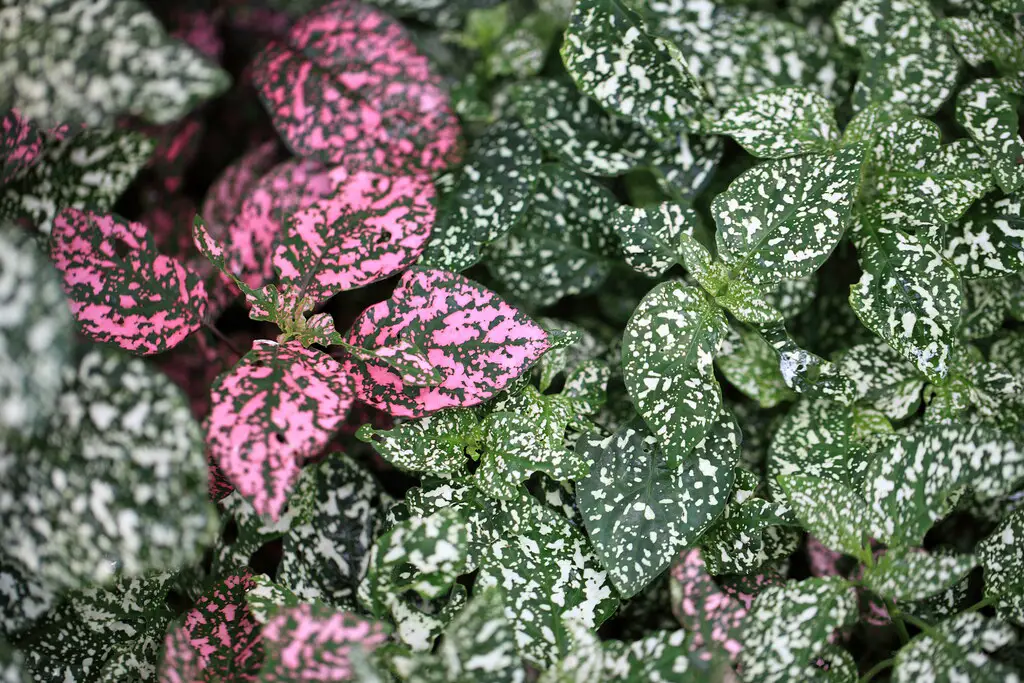Hypoestes, commonly referred to as the Polka Dot Plant, is a colorful and eye-catching plant known for its vibrant foliage. Native to Madagascar, Hypoestes sports dotted patterns on its leaves, typically in shades of pink, white, or red against a lush green background. These vivid dots give the plant its common name and make it a unique and striking addition to any indoor or outdoor garden.
Belonging to the Acanthaceae family, Hypoestes offers endless opportunities for creativity, especially in mixed container gardens where it adds a splash of color and whimsy. As an evergreen perennial, it retains its bright, cheerful appearance year-round and is often used as a houseplant in colder climates or as a bedding plant in warmer regions.
Growing Hypoestes is an enjoyable endeavor for gardeners of all levels, as it’s relatively easy to care for and tolerates a wide range of conditions. Despite its hardy nature, understanding its specific needs is essential for fostering optimal growth, flowering, and leaf coloration. This includes attention to lighting, watering, temperature, and other care requirements.
| Attribute | Details |
|---|---|
| Common Names | Polka Dot Plant |
| Botanical Name | Hypoestes phyllostachya |
| Family | Acanthaceae |
| Plant Type | Evergreen Perennial |
| Mature Size | 8-24 inches in height |
| Sun Exposure | Partial shade to full sun |
| Soil Type | Moist, well-drained soil |
| Hardiness Zones | 10-11 |
| Native Area | Madagascar |
Hypoestes Care
Hypoestes or Polka Dot Plant care is quite straightforward, making it an appealing choice for both beginners and seasoned gardeners. Its bright, speckled foliage thrives in various lighting conditions and can adapt to different soil types. While it appreciates consistency in watering and temperature, it’s forgiving and can bounce back from minor care mistakes.
Though often grown for its attractive foliage, Hypoestes also produces small, inconspicuous flowers. Proper care that caters to its specific needs, such as optimal light exposure and a balanced watering routine, will ensure that the plant continues to flourish and maintain its appealing appearance.
Light Requirement for Hypoestes
Hypoestes prefer bright but indirect sunlight. While they can tolerate partial shade, a lack of sufficient light may cause the vibrant coloration of the leaves to fade. An east or north-facing window that provides filtered sunlight is usually an ideal spot for indoor Hypoestes.
Soil Requirements for Hypoestes
A well-draining soil mixture that retains moisture is ideal for Hypoestes. A standard potting mix enriched with organic matter or compost will provide the necessary nutrients and allow for the right balance of moisture retention and drainage.
Water Requirements for Hypoestes
Watering should be consistent but cautious, as Hypoestes likes to be kept moist but not soggy. Allow the top inch of soil to dry between watering, and reduce the watering frequency during the winter months.
Temperature and Humidity
Hypoestes prefer a temperature range of 60-75°F (16-24°C) and thrive in moderate to high humidity. In dry environments, misting the leaves or using a humidifier can help maintain the desired humidity levels.
Fertilizer
Feeding Hypoestes with a balanced, all-purpose liquid fertilizer every 4-6 weeks during the growing season will support healthy growth and vibrant leaf coloration.
Pruning Hypoestes
Pruning can be beneficial for maintaining the desired shape and promoting bushier growth. Pinching back the stems encourages branching and helps the plant maintain its compact, attractive form.
Propagating Hypoestes
Propagating Hypoestes is generally done through stem cuttings. Snipping a healthy stem and placing it in water or soil to root creates an easy way to multiply this colorful plant.
How To Grow Hypoestes From Seed
Growing Hypoestes from seed is feasible but requires patience. Sow the seeds in moist soil and maintain a warm, humid environment. Germination typically occurs within a few weeks.
Common Pests & Plant Diseases
Spider Mites
A common problem that can be treated with insecticidal soap or neem oil.
Powdery Mildew
Avoid overwatering and ensure proper air circulation to prevent this fungal disease.
Common Problems With Hypoestes
Loss of Color
Inadequate light can cause a loss of vibrant leaf coloration. Increasing light exposure can often correct this issue.
Leggy Growth
If the plant becomes leggy or sparse, it may need more light or pruning to encourage bushier growth.
Pro Tips
- Provide bright, indirect light to maintain leaf coloration.
- Use well-draining soil and avoid over-watering.
- Maintain moderate humidity through misting or using a humidifier.
- Pinch back for bushier growth and prune as needed.
- Consider mixing Hypoestes with other plants in containers for a colorful display.




